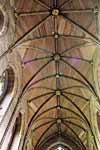For this church:    |
| ||||||||||||||||||||||||||||||||||||||||||||||||||||||
 Sketch of Sketch of second chapel |
 Ordnance Survey Ordnance Survey map of 1886 © Crown Copyright and Database Right 2015. Ordnance Survey (Digimap Licence) |
The second chapel was positioned some 70 metres south-west of the present site and was designed by T.C. Hine of Nottingham who commenced construction in 1865 but, owing to the lack of funds, work ceased in 1868 and remained uncompleted until its removal some years later following the disastrous fire at the house in 1879.
Again little trace can be found above ground however aerial photographs reveal an outline of the chapel with its semi-circular east end detail found at the south western end of the lawn in front of the Parsonage. This chapel is clearly shown on the 1:2500 scale Ordnance Survey map of 1886.
The existing chapel was built in the period 1886-89, with funds provided by the 7th Duke of Newcastle, following the removal of the unfinished structure of a second chapel. Even when this chapel ceased being used some years later it was conveniently used as a large storage area when the house was dismantled.
 The present building is of a Victorian neo-Gothic Revival style which placed an emphasis on the Duke’s wishes for a model church for Anglo-Catholic worship was designed by George Frederick Bodley, from the renowned Bodley & Garner partnership. The dedication was later changed from the Blessed Trinity to the Chapel of St. Mary the Virgin.
The present building is of a Victorian neo-Gothic Revival style which placed an emphasis on the Duke’s wishes for a model church for Anglo-Catholic worship was designed by George Frederick Bodley, from the renowned Bodley & Garner partnership. The dedication was later changed from the Blessed Trinity to the Chapel of St. Mary the Virgin.
 Patrington Patringtonchurch spire |
This 14th century English Gothic style was much revered by Bodley but did not form part of his main portfolio, until this commission. It is generally considered the cruciform footprint shape and specifically the distinctive spire was developed from that of the parish church of St. Patrick at Patrington in the East Riding of Yorkshire, known locally as the Queen of Holderness, built in 1310-1420.
Whether this came to mind by Bodley, or the Duke perhaps reading about Captain William Bligh [of HMS Bounty fame] in the Daily Telegraph, who used the Patrington’s 189 foot church spire as a marker for his survey of the river Humber from Spurn Point onto the west of Sunk Island, on HMS Director, in February 1797, is open to conjecture, but the similarity of the design, with the spire rising out of an octagonal corona, which sits at Patrington some 84 feet above ground, on the tower, appears to confirm the point.
Bodley’s ‘cathedral in miniature’, as it is aptly called at Clumber, has a tower which is surmounted by a spire rising to an overall height of 180 feet. The orientation is approximately east-west, as distinct from its predecessor, and is 137 feet in length.
The cruciform shape when measured through the crossing, transepts and buttresses is a little over 70 feet. The chancel and nave have four bays, but the appended Lady Chapel to the south of the chancel and vestry to the north, each have three. The chancel stretches internally 50 feet eastwards from the rood/dividing screen, and the nave, including the central crossing, some 70 feet.
This internal footprint is a little smaller than Patrington, which has an overall external length of 150 feet and breadth of 90 feet, but still enjoys that scale and appearance of majesty, stability and permanence.
There has been little change to the structure of the chapel since its original construction, except stone repairs and the like, save the movement of the stone pulpit, from the north-eastern end of the nave onto the tower supporting column at the northern end of the screen. This is a point not lost when comparing Brewer's perspective painting of this area.
 The tower from The tower fromthe south-west |
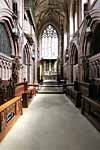 The chancel The chancellooking east |
 The nave The navelooking east |
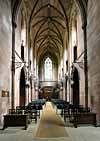 The nave The nave looking west |
 The Lady Chapel The Lady Chapellooking east |
Stonework
Interior
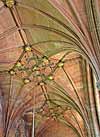 Lady Chapel Lady Chapelceiling |
 Ceiling of Ceiling ofBaptistery |
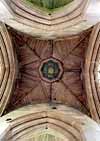 Central Centralcrossing ceiling |
 Archangel Gabriel Archangel Gabriel |
The nave has a sill band along its length with regular stone benches and blind arcades provided with moulded arches.
Ceilings
The carvings to the arches, ribs, and roof bosses are of great interest. The two in the chancel are embellished with representations from both the Nativity and Crucifixion.
The internal roofs in both the Lady Chapel and Baptistery are also highly decorated.
The vaulted ceiling of the Lady Chapel |
|
 |
|
| incorporates the opening verses of the Virgin Mary’s Song of Thanksgiving, [Luke 1:46-55], also called the Magnificat. Perhaps the first word of the hymn, in Latin, ‘Glorifies’ is well chosen for this distinct embellishment to the building. | |
 |
|
The ceiling of the baptistery |
|
 |
|
| is quartered and enhanced with a strong blue colouration. Within the centre of each quarter is the sacred monogram, ‘IHS’. Two of the diagonally opposite quartered sections bear the inscription, ‘Sanguis Christi salva nos’, [Blood of Christ save us]. The corresponding diagonals are inscribed, ‘Aqua lateris Xti lava nos’, [Water from the side of Christ, wash us]. | |
 |
|
The central crossing ceiling |
|
 |
|
| is quartered twice and the resulting octagon high overhead bears the sacred monogram again but is enriched by the circle of surrounding words, ‘Jesu tibi sit gloria’, [Jesu, to Thee be glory]. This is one of the few painted surfaces in the Chapel which has been designed by Bodley. | |
The niches on the east wall of the chancel are occupied by stone carvings of angels which bear instruments of the Passion. On the north side, the nails, ladder, spear and the reed, with the southern side bearing, the hammer, pincers and the scourges.
The Crossing buttresses have two figures adjacent to the Dividing screen of the Chancel, to the north Archangel Gabriel, and to the south the Blessed Virgin Mary, which owing to their position clear observation can be made as to the quality of the detail.
External
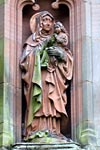 St Anna St Anna |
 St Elisabeth St Elisabeth |
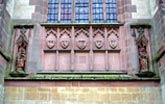 Panels beneath Panels beneatheast window |
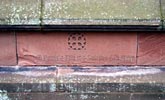 Foundation stone Foundation stonebelow panels |
 St Michael St Michael |
 St Paul St Paul |
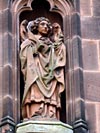 Recording angel Recording angel |
The niches in the external walls incorporate eight stone figures, six of which were progressively added between 1912 and 1922.
The eastern elevation
The eastern elevation incorporates on its southern [left] side what is believed to be St. Anna, daughter of Phanuel, of the tribe of Aser [KJV], Asher [NIV], holding the Child Jesus, whose story is noted in Luke’s Gospel Ch. 2 : vs 36; and to the north [right], St. Elisabeth, holding her and husband Zechariah’s miracle son, John, later the Baptist, which also incorporates a halo within the carving detail. The reference is covered in Luke’s Gospel Ch. 1 commencing at vs 5.
The five panels below the east window each supporting a monogram, with the Sacred Name ‘IHS’ in the centre, from the left [south], an angel – relating to St. Matthew; a lion – to St. Mark; a calf – to St. Luke; and an eagle – to St. John.
The Chapel foundation stone with its low aspect ratio, can be found at the foot of this elevation and bears and engraved cross below which is placed the inscription, In Nomine Patris et Filii et Spiritus Sancti : Amen [In the name of the Father, and of the Son, and of the Holy Spirit : Amen].
The western elevation
The western elevation supports two stone figures, one on each side of the west window. The one to the north [left] depicts St. Peter, holding keys and a book, whilst that to the south [right], St. Paul, with sword and book.
The southern elevation
The southern elevation has several aspects.
The central tower incorporates St. Michael, holding a spear.
Above the south door, complimenting the subjects within the south transept stained glass window, we have The Recording Angel to the west [left], holding a pen, and to the east [right] the Guardian Angel, holding a cup. These are of great interest as they are rarely to be found on places of worship.
On the corner of the South Passage, facing south-west, The Virgin and Child.
The general roof edge detail
This incorporates on the north, east and south elevations, crosses and on the west, a crucifix.
The eastern end of the Lady Chapel roof is a cross with a fleur-de-lis detail below.
The Sacred Monogram, IHS occurs in several places around the walls and on the heads of all the rainwater hoppers/pipes.
Eight gargoyles are perched along various points around the roof edge detail.
Technical Summary
Timbers and roofs
Bellframe
Composite frame of wooden top and bottom cills with cast-iron braces.
Not scheduled for preservation Grade 4.
Walls
| NAVE | CHANCEL | TOWER | |
| Plaster covering & date | No plaster. All built with open stonework. | No plaster. All built with open stonework. | No plaster. All built with open stonework. |
| Potential for wall paintings | None. | None. | None. |
Excavations and potential for survival of below-ground archaeology
The fabric of the entire building dates from 1886-9 on a new site which was previously used as landscaped parkland. It is expected that the entire stratigraphy will date from 1886-9.
There is no defined churchyard. The building sits amidst park landscape with no discernible divisions to its perimeter. No burials occur externally.
The overall potential for the survival of below-ground archaeology in the churchyard (ie. the area immediately surround the chapel), is considered to be LOW comprising mainly construction evidence from 1886-9, paths, and other landscaping. Below the present interior floors of the nave and chancel it is considered to be LOW being principally stratigraphy from the 1886-9 building; there is no evidence of burials. The archaeology of the upstanding fabric is principally that of a single building phase of 1886-9 and is representative of the architecture of George Frederick Bodley and Thomas Garner; as a representation of late-Victorian church archaeology its potential is VERY HIGH. There is an UNKNOWN potential for earlier stratigraphy relating to the site prior to its use as parkland.
Exterior: There are no burials. Deposits around the church may contain evidence of the 1886-9 construction.
Interior: Stratigraphy under the entire building is likely to comprise, almost exclusively, 1886-9 and later deposits. Upstanding fabric is largely intact from the same period.




